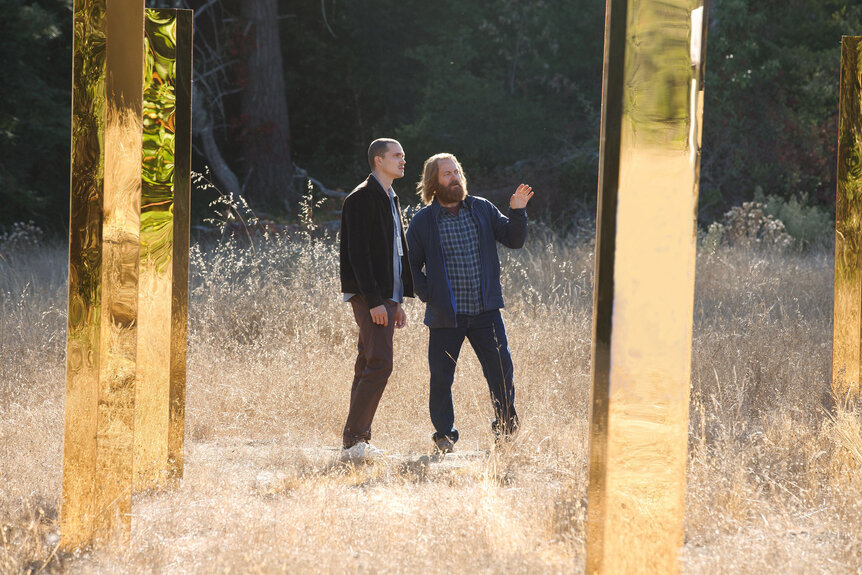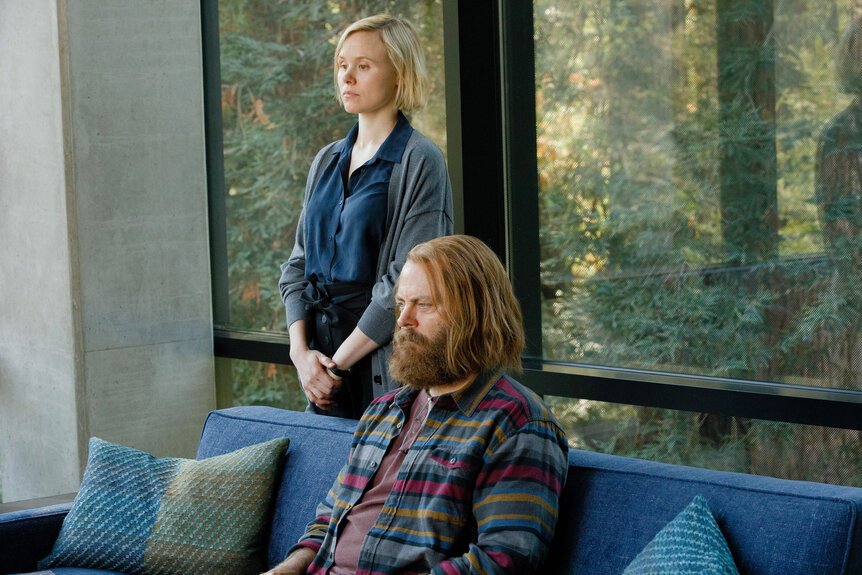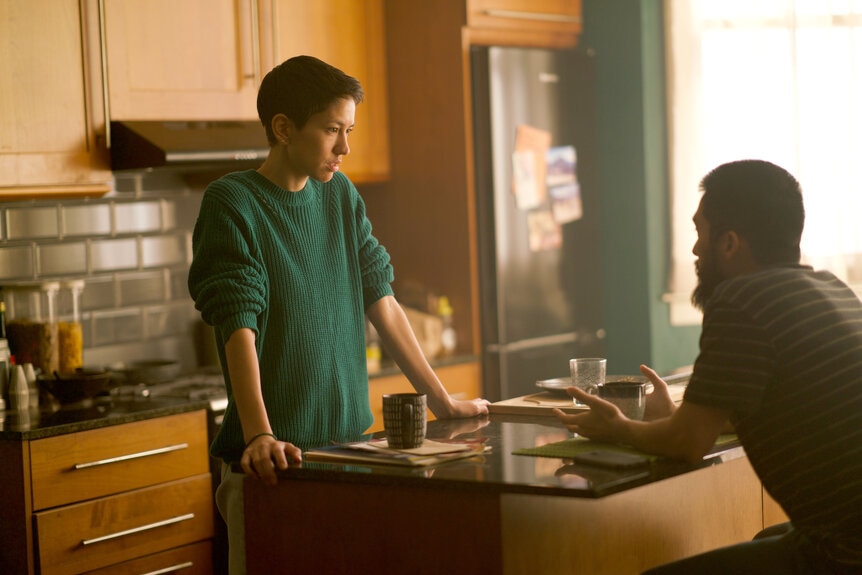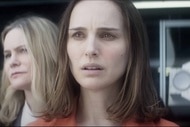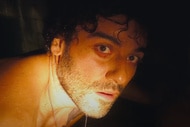Create a free profile to get unlimited access to exclusive videos, sweepstakes, and more!
Devs creator Alex Garland and cast break down the first mind-trippy half of Season 1
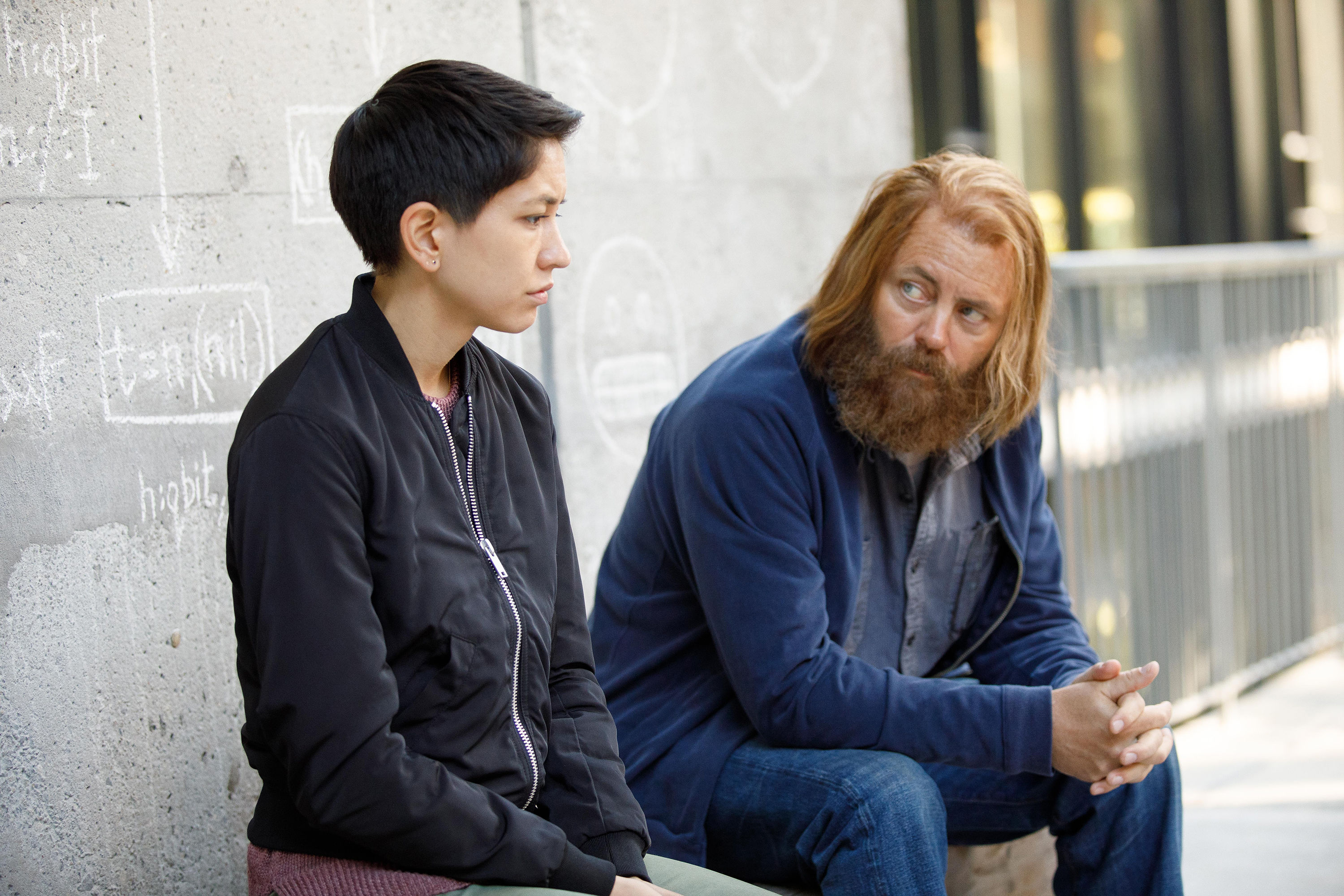
One of the flagship series for the new FX on Hulu co-branding effort, Devs is also writer/director Alex Garland's first foray into television. Sci-fi fans will know his work from Dredd, Ex Machina, and Annihilation, of course. As an eight-hour standalone series, Devs continues to expand on themes Garland often explores: technology’s impact on humans, determinism vs. free will, unregulated creation, and the beauty of science — and what it reveals about us.
**SPOILER WARNING! Spoilers below for the first four episodes of Devs!**
Throughout Season 1 of Devs, we’ll check in with Garland and his cast about pivotal episodes that break apart and reveal so much about what he’s trying to put across to audiences in the series. For the mid-point of the season, SYFY WIRE sat down with Garland and several members of his cast including Sonoya Mizuno (Lily), Nick Offerman (Forest), Jin Ha (Jamie), and Alison Pill (Katie) to talk about the visuals that set the tone of the series, and the ongoing motivations of Lily Chan, Jamie, Forest, and the woman who truly operates Devs, Katie.
The Amaya campus centralizes the visual aesthetics of the entire series with the cold, enigmatic nature of the compound being overseen by a mega child effigy. It's juxtaposed with the almost womb-like warmth of the inner Devs compound.
On the haunting look of the Amaya campus:
Alex Garland, Executive Producer/Writer/Director: In the case of the campus, the production designer, Mark Digby, and set designer, Michelle Day, went on a trip and they found the University of Santa Cruz. They took some pictures and they said, "We think we found the campus."
On creating the unique Devs building:
Garland: In the case of the big floating cube, that is a Menger sponge. It's a fractal shape. I came across that, because in Annihilation, the physical structure of the alien when we first see it, is a fractal shape for the Mandelbrot. Which is like a 3-D representation of the Mandelbrot.
And one of the other three-dimensional fractal shapes I came across was this sponge. I thought, "This will be a beautiful housing for the machine." The quantum computer itself is actually based on what quantum computers really look like, inside their housing.
On the path from Amaya to the secret Devs building:
Garland: The closer we got to the cube, the more beautiful and the more mysterious, and the more magical the space is. It's lyrical, but that was the thing we were shooting for. And it happens in stages. As you walk through the forest, there's these strange halos around the trees. Outside the cube, Michelle created these gold bars. And then you walk down this passage, and suddenly, you're in this beautiful, floating fractal shape. It’s seductive, hopefully.
The cast of characters are all enigmatic: withholding, but not without warmth and humor. The series makes a point of presenting the uniqueness of the individuals who can process the levels of thought needed to bring forth the science being explored. But there's also an emotional sacrifice that comes with that level of ability. The cast talks about building their characters...
On creating a tech genius billionaire:
Nick Offerman (Forest): Alex did so much of the heavy lifting for me, like handing me the Amaya Corporation. So we have the physical evidence, the artifacts right on camera of my coding, of my expertise, of my former brilliance… whatever that may be.
On creating Forest's enigmatic right-hand woman:
Alison Pill (Katie): [Alex and I] had more discussions about what it would be like to operate in the world knowing what she does. She's got a worldview that has not been there before. And to a different person that might mean loneliness, it might mean dissatisfaction or depression. But I think Katie is so scientific that it is just really cool and thrilling and logical. And that fact makes everything that follows, even the bits that are hard to accept as a scientific mind, there's a real peace with it. She's such a singular character to me.
On creating an unexpected protagonist with Lily Chan:
Sonoya Mizuno (Lily Chan): Lily is brave and she's resourceful and she's extremely intelligent. And she's also making mistakes with her exes and what have you. She does the "wrong things," And what we really tried to go for, what was important, was that she didn't feel like a typical protagonist.
We also wanted her to feel different because she was truer, actually, to so many of the women that I know and that lots of us know. We really wanted to take a risk there with that. And that went to things like the way she dressed and her hair. She's an outsider. So how does an outsider claim their space? What can we do to make her look like an outsider but without making her look affected or part of a tribe? And she's special as well, too.
On how Jamie was inspired by real-word tech employees:
Jin Ha (Jamie): I connected with somebody who had worked in cybersecurity at Google, and, I believe, worked for the government as well in cybersecurity at one point. We met at a barbecue spot in Santa Cruz off the highway. I understood, meeting him, I'm not going to learn a fraction of what he knows, but I can at least, as an actor, try to approach it like how does this person's brain work, and how did he think? How does he interact with the world? A lot of it was very insightful in terms of his job, which was to constantly be preempting possible attacks or possible leaks or possible holes that could erupt in a cyber system. That's an interesting way of seeing the world, in my opinion, of constantly imagining the worst‑case scenario in order to prepare for it.
In addition, I was watching his hands because it was interesting to think about this is his well‑being, and this is how he communicates, and this is his livelihood. How does he use his fingers while he talks? I don't know how much of that translated into the actual performance, but it was really exciting for me to be able to have a one‑on‑one with somebody who embodies and lives this character's occupation and mind‑set for a living.
On creating Lily's unique physical presence in this very specific profession:
Mizuno: A lot over the years, [Alex and I] have had conversations about what it is to be a female Asian in this industry and what the roles are like. So also played a part [in creating Lily]. And I would think about, "Okay, so who's this person who is trying to do the right thing, trying to tell the truth, how would she stand?" I always try to think of her as just being very open.
On the gender dynamics that Katie navigates in the upper echelons of science:
Pill: I think in her mind, and in most places, she's the boss. So I don't think she actually feels like those gender dynamics bother her. I think they might've at one point in her life. I think in school and going into tech and being a young coder, being in physics, being in [advanced math] at all as a woman. But at a certain point, I think the gender biases with such smart people breakdown.
On Jamie being a bridge between the tech world and the heart for Lily:
Ha: There are some larger questions of technology and advancement of technology in terms of what one tech genius' dream is. And at the same time, there is also, on a very micro scale, someone who is being reconnected with an ex who [Jamie] still feels incredibly, cosmically attracted to. That's incredibly high stakes for Jamie's character, but not on the same level as what Amaya, the company, is trying to do. But at the same time, for Jamie, it's the biggest thing in his life.
On Katie's belief and support of rules, but her own propensity to break them:
Pill: It's such an interesting thing, because if it's a deterministic world, she's not doing anything she would never have done. Listen, it's a real mindblower. (Laughs)
The series leans on needle drops and visual motifs in unusual ways. Here, Garland explains some meaningful choices in the first four episodes...
On creating the overall cinematic aesthetic to the Devs world:
Garland: With this collective, many of us worked together for a long, long time. For example, in the case of score, one way of having a score written is that a writer writes something, a director shoots it, an editor and a director cut it. And then, the nearly locked edit is shown to the composer, and they have six weeks to write a score.
With Geoff (Barrow) and Ben (Salisbury), we work in a completely different way. We work in exactly the same way as with everybody else. Everybody is bought in at the beginning. This is before pre-production started. I send Geoff and Ben the script. During pre-production, they come into the office. They see the set design, they see the costume design, we talk about what we're trying to build. They come to the shoot, while we're shooting it. And then right from the beginning, the first scenes being put together, they'll come in and watch half a scene, or a full scene put together. And so, they are integrally part of it, the whole way through. And all of us together are figuring out what the end destination is.
On the use of “Congregation” by Low to open “Episode 2”:
Garland: I was aware within television there was a convention of a recap of the previous episode. And I was thinking, in this story, which is about things you can look back on, which is a recap, and you can also look forwards. I thought, "I'll try to do a sort of abstracted version of a recap, and make juxtapositions of images, from which a kind of meaning can float out. And then try some very complete music choices," which we let fully play out.
“Congregation” was suggested by Geoff, and he said, "I think I've got a great track for the opening of Episode Two." He sent it to me and I was just like, "Holy s**t, it's f***ing amazing!”
Devs drops new episodes Thursdays on FX on Hulu.
